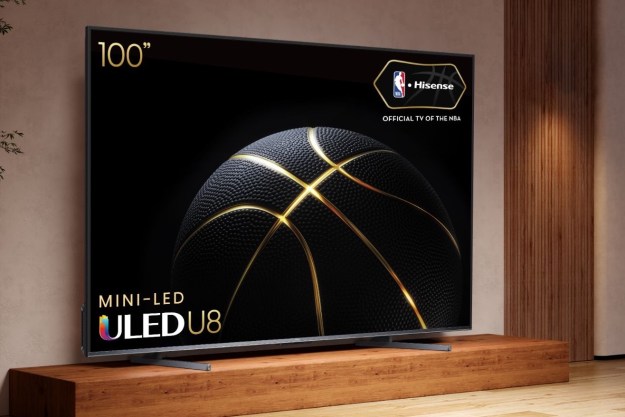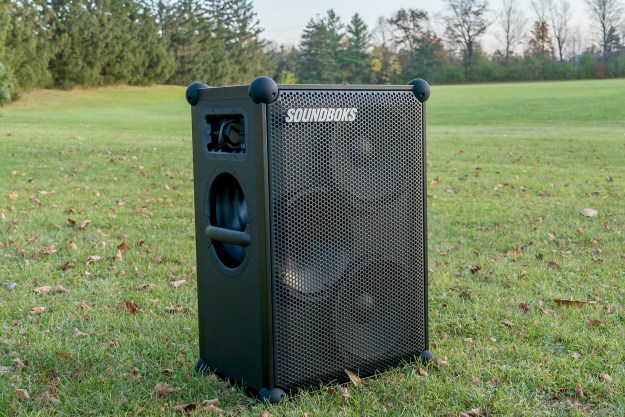
“It's big enough, it's loud enough — and, gosh-darn it, Soundboks 4 is easy to use.”
- It's big, but not too heavy
- More refined than its predecessors
- Good total volume
- Easy to use
- Get two and stereo pair
- No option for continuous power
- Could use more Bluetooth codecs
- Expensive
Many audio brands routinely boast about how loud and raucous their speakers can get, but few can rumble in and set the bar higher and louder. It is a case where size matters since a bigger speaker should rock the house, which is exactly what the Soundboks 4 is built to do.
By Bluetooth speaker standards, the Soundboks 4 is monstrous — and so is the $1,000 price tag. But it also doesn’t have too many competitors in the same weight class. It’s heavy enough at 35.5 pounds and pumps out up to 126 dB max volume, with three 72-watt amps. (This puts it about half of the weight and output of the JBL PartyBox Ultimate, but also a good bit less expensive.) So you’d have to be thinking of throwing a party or two to justify both the space and expense. If that’s something you’re down for, this speaker will be all too happy to move a crowd.
Soundboks 4: design

The Soundboks 4 looks a lot like its predecessor, though it has new components inside that give it a decided sonic edge. Measuring 25.6 by 17 by 13 inches, the speaker is also only an inch deeper than the previous model. So despite making several changes underneath, it doesn’t come with any significant inconvenience (relatively speaking) in both size and weight. The poplar cabinet is more than sturdy, with an IP65 splash-proof body and silicone ball corners to cushion it in whichever orientation you prefer, be it upright or sideways.
It also retains the trappings of the previous model, which explains why the steel handles, pole mount, buttons, battery pack, and ports are all in the same locations. The grille also comes off, sticking to Soundboks’ preference for personalization if you want to choose a slightly different look from the brand later on. It makes sense from a longevity standpoint because this isn’t the kind of speaker you buy and discard a year or two later. You’re getting it for the long haul.
As before, the battery is removable — what the company calls Batteryboks.
The Soundboks 4 has three 72-watt Class D amplifiers, two 10-inch woofers, and a single 1-inch compression driver tweeter. A “next-gen” adaptive digital signal processor also helps with clarity and a bass boost. There are two quarter-inch inputs that would work perfectly with guitars, other instruments, mixers, and other audio equipment, along with a 3.5mm input and 3.5mm output. If you want to use a microphone to make an announcement, presentation, or sing karaoke, you only need the right cables and gear to do it.
As before, the battery is removable — what the company calls Batteryboks. These large packs are swappable, so if you want a backup for any particular reason, you can and have it handy to keep the audio going until the next one is ready to slide back in. It takes about 3.5 hours to charge each one from empty to full.
Soundboks 4: setup and configuration
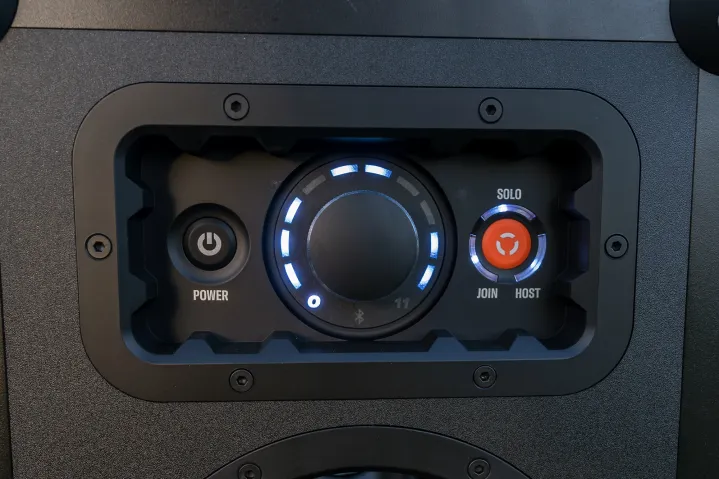
It’s not hard to navigate what the Soundboks 4 does, especially if you’re already familiar with its previous iterations. The volume dial also acts as the power button when you press it, surrounded by LEDs to indicate how high or low the sound is. As always, it goes up to 11, in an amusing ode to Spinal Tap (like other Soundboks speakers). To the side is an orange function button that can set the mode the speaker is currently in. For example, it’s possible to wirelessly link to another Soundboks 4 so that they play the same music from different areas of a large room with one speaker acting as the host. Or, you can stereo-pair them for dedicated left and right channels, which may be ideal if you’re setting them up on a stage.

Because the software is the same, it’s also possible to link the Soundboks 4 with the Gen3 or Soundboks Go — but not as a stereo pair, only in playing the same content. Another way is to daisy-chain two or more speakers together through the 3.5mm inputs and outputs, which you could pull off by setting both speakers as hosts and plugging them into each other. That way, you only need to pair with one speaker yet play audio from all of them in the chain.
If you prefer to keep things as wireless as possible, know that the Skaa wireless streaming protocol also returns here. It uses the 2.4GHz band to establish a low-latency connection with multiple speakers simultaneously.
Soundboks 4: using the app

Pairing the Soundboks 4 to a mobile device or computer via Bluetooth is easy enough. It’s also just a bit unusual that the company didn’t upgrade from Bluetooth 5.0, but it may not matter as much if you don’t plan on venturing too far away from the speaker anyway.
The details are in the Soundboks app for iOS or Android, where you can tweak the sound and configure certain features. It’s also where you install firmware updates. Soundboks retains the same sound modes it previously offered, all of which you can apply as the need or situation arises. Despite its booming repertoire, the speaker works just fine in quieter settings, which explains why there’s an Indoor mode that tamps down on the bass, whereas the Bass+ mode ramps it up. Loud mode is just as it implies, boosting everything to deliver the boom the speaker was ultimately built for.
The in-app EQ allows you to tweak the sound however you like, no matter which mode you’re playing in. If a combination really works, save it as a preset for the added convenience of toggling it on in the right situation. Existing presets like Stage, Dancefloor, and Lounge can also give you a template for finding the right sound based on the space or acoustics you’re dealing with.
Soundboks 4: sound quality
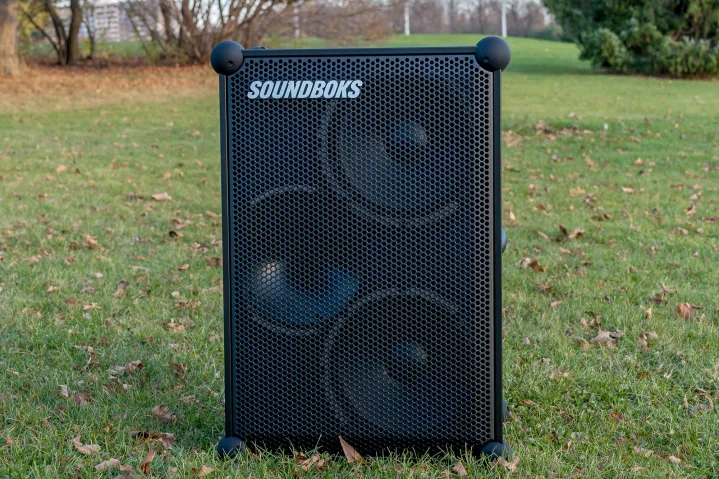
Anytime you come across a speaker that can theoretically hit decibel levels 30 times that of a lawnmower, you experiment cautiously in increasing the volume. My previous experience with Soundboks speakers gave me the impetus to take the same approach as before: gradually increasing the volume under the right conditions to gauge how much attention the Soundboks 4 could attract. There’s no question the speaker is a head-turner for the simple fact it gets ridiculously loud. I’m not exaggerating when I say it would be all you need to entertain 100 guests in an indoor or outdoor space. DJs could just as easily hook up their gear to it and get the party started, too.
If you’re new to the brand, a first glance at this thing will likely conjure up images of the sort of speakers you’d see in nightclubs or rolling into venues for live music performances. That’s partly the point here. Only it’s not surprising it gets really loud — too loud for most scenarios when you turn the dial closer and closer to 11. But that’s OK since Soundboks finds a way to make the speaker a lot more adaptable this time.
In other words, it’s not necessarily louder than its predecessors; it sounds clearer and more refined.
In other words, it’s not necessarily louder than its predecessors; it’s that it sounds clearer and more refined. Indeed, this one spoke to me more for how good it was at reasonable volumes indoors than it was for playing something loud outdoors. I particularly like how live recordings play, including high-quality ones via YouTube, where the speaker’s drivers do a great job of bringing in the nuances of a concert. It’s the same with podcasts and lectures, which the Indoor setting handles with aplomb.
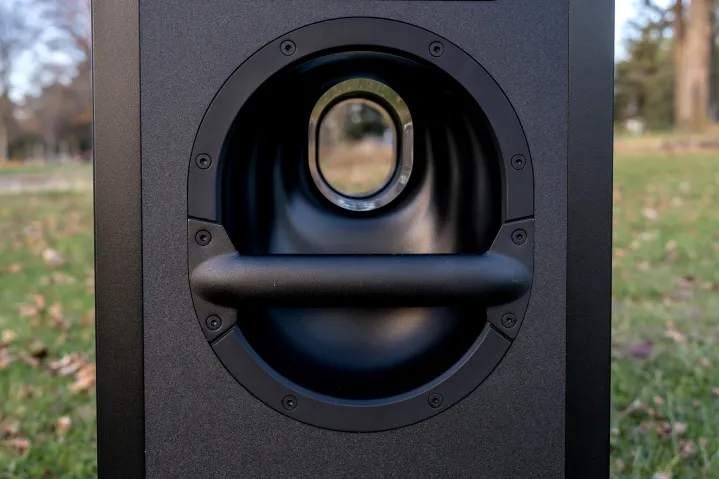
The tipping points otherwise largely remain the same, meaning that turning the dial from 5 to 6 or 8 to 10 leads to a dramatic difference in output as far as loudness goes. More impressively, the clarity manages to hold at louder volumes, though you will hear hints of distortion if you’re closer to the speaker when it’s really loud.
I just wish Soundboks considered adopting more Bluetooth codecs to help the cause. As is, it only does SBC, which is fine, but I always wondered what it might sound like if the speaker could also do aptX HD or LDAC. Wired playback with a DAC could presumably get around that restriction, but wireless connectivity is part of the appeal here, and given the price tag, it would’ve been nice to get something extra, sonically speaking.
Soundboks 4: battery life
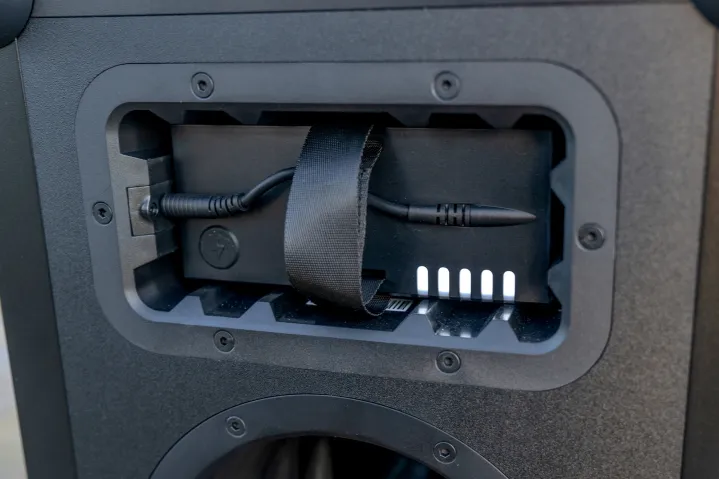
It’s hard to rate battery life with a speaker like the Soundboks 4 because being loud is such a big part of its cachet. The company says you can expect up to 40 hours at mid-volume — so about 5 on the dial — but it precipitously drops the louder you go, all the way down to six hours when ramped up to 11. Hence, a backup battery becomes critical if you’re hosting a party and don’t want it to die down once the juice runs out.
That’s all the more important because you can’t just play it while plugged into an outlet and leave the battery aside. The T-jack allows for plugging into both the battery and speaker simultaneously, except Soundboks recommends not leaving them plugged in like that for more than six hours because the charger was never designed to work as a constant power source. There is short-circuit and overheat protection in case something goes wrong in the interim. But either way, you need to think tactically about how you would use the speaker over long periods. That includes when using it indoors with a mixer or DJ equipment.
The improved performance makes the Soundboks 4 a very compelling choice in a speaker subset that isn’t rife with a lot of good options. There are certainly other big Bluetooth party speakers that exist purely to entice people to enjoy themselves surrounded by a huge soundstage. After all, it’s one thing to hear the music from across a big room, and it’s another to hear it from a block away.
It’s also more versatile than it seems. For example, speakers like this benefit from the increasing portability and miniaturization of projectors. It’s not hard at all to set up a portable projector and plug it in directly to the Soundboks. Before you know it, you have a fun theater of sorts in the backyard or patio to entertain a group, provided you have a screen or white wall to project onto. Community events and festivals are also much easier to manage from the audio side when you only need a single microphone to address a crowd.
The main thing is to justify why you would want a Soundboks 4. If you’re the type to throw parties and love entertaining big crowds, you will be more than pleased at its ability to do just that, much like you will when you dial it down and want some background tunes at home or by the pool.
Editors' Recommendations
- Best Bluetooth speaker deals: Save on Marshall, Sonos, JBL, and more
- Klipsch cranks up the karaoke with its first wireless party speakers
- IP what? Explaining water and dust resistance for audio gear
- Edifier MP230 Hands-on Review: The pint-sized, retro Bluetooth speaker brings a vintage vibe
- JBL Charge 4 portable Bluetooth speaker is $80 off for Black Friday


